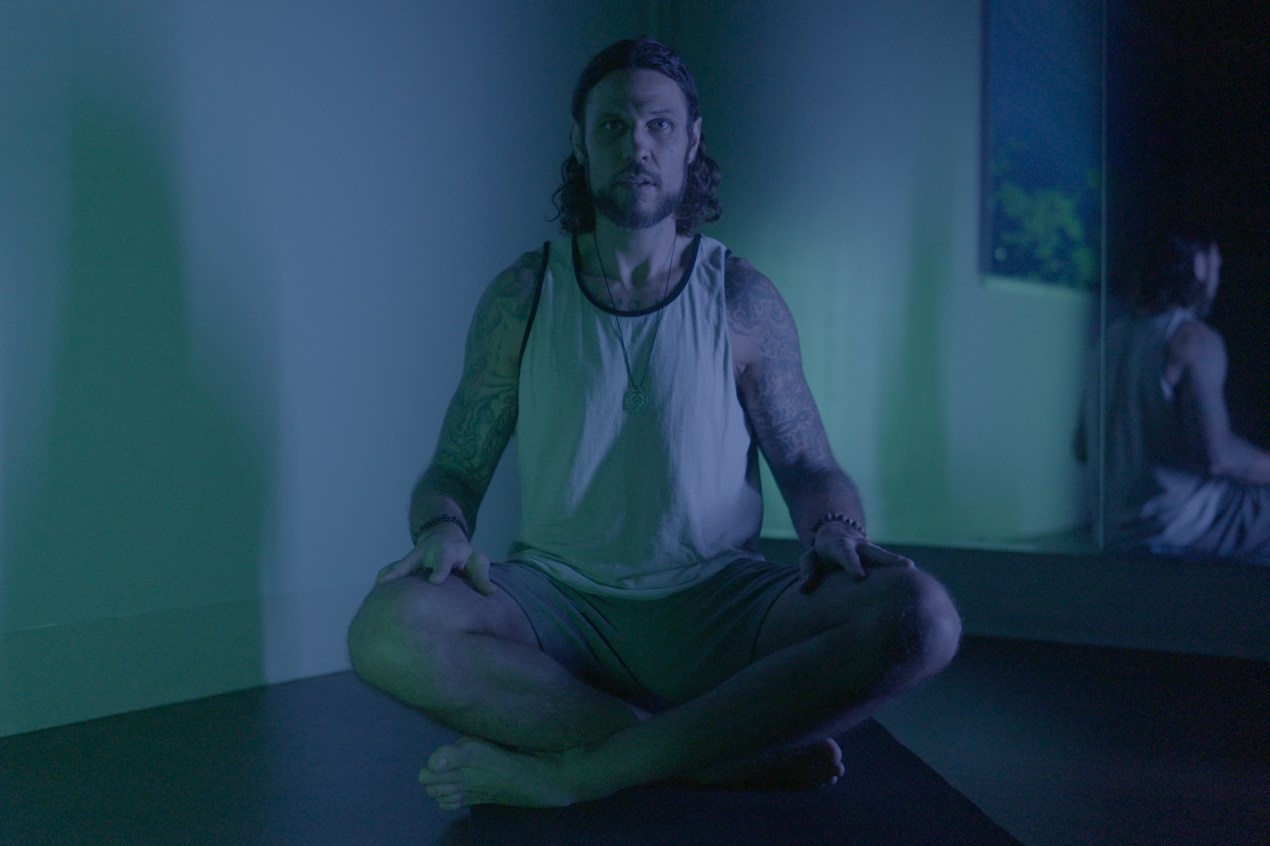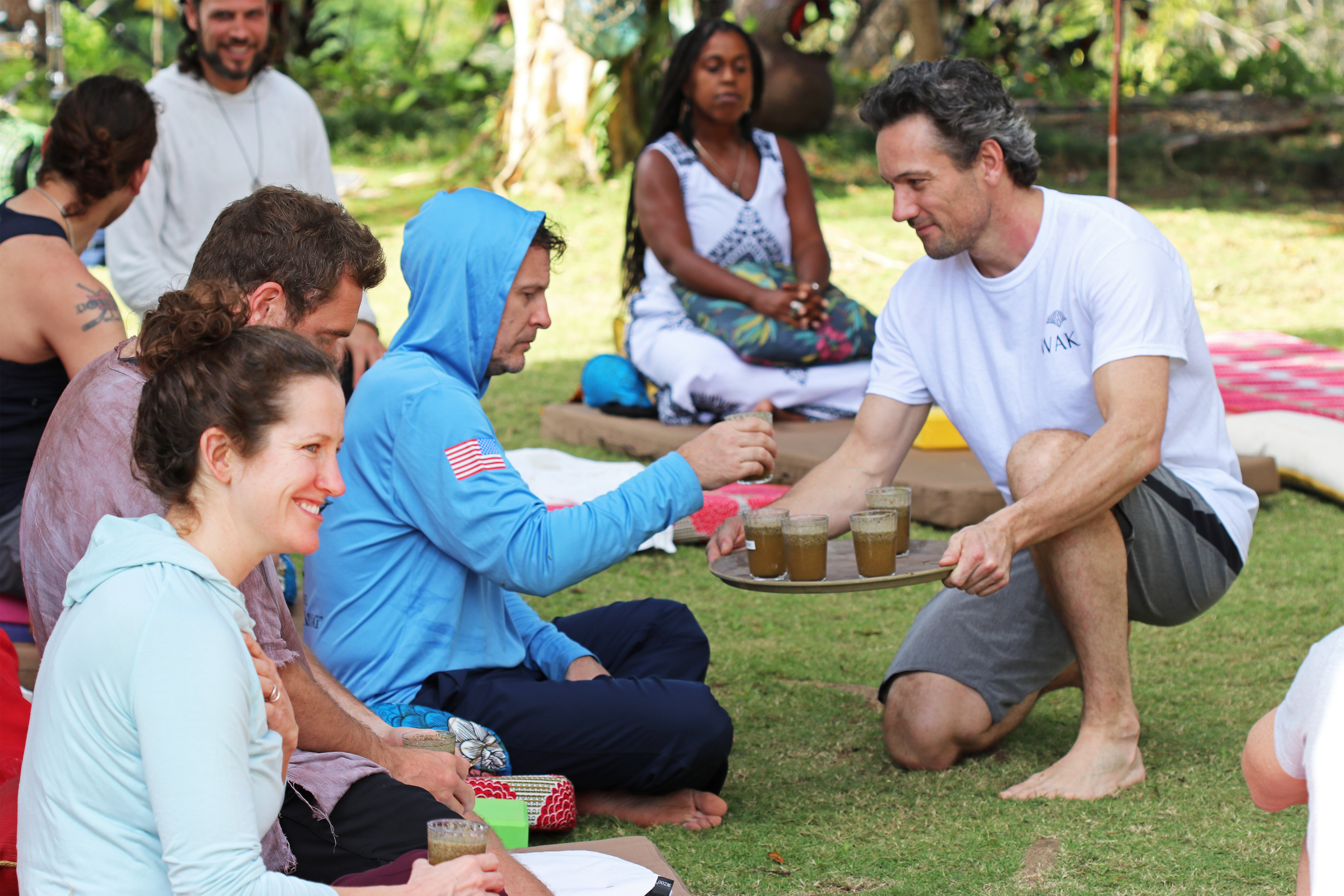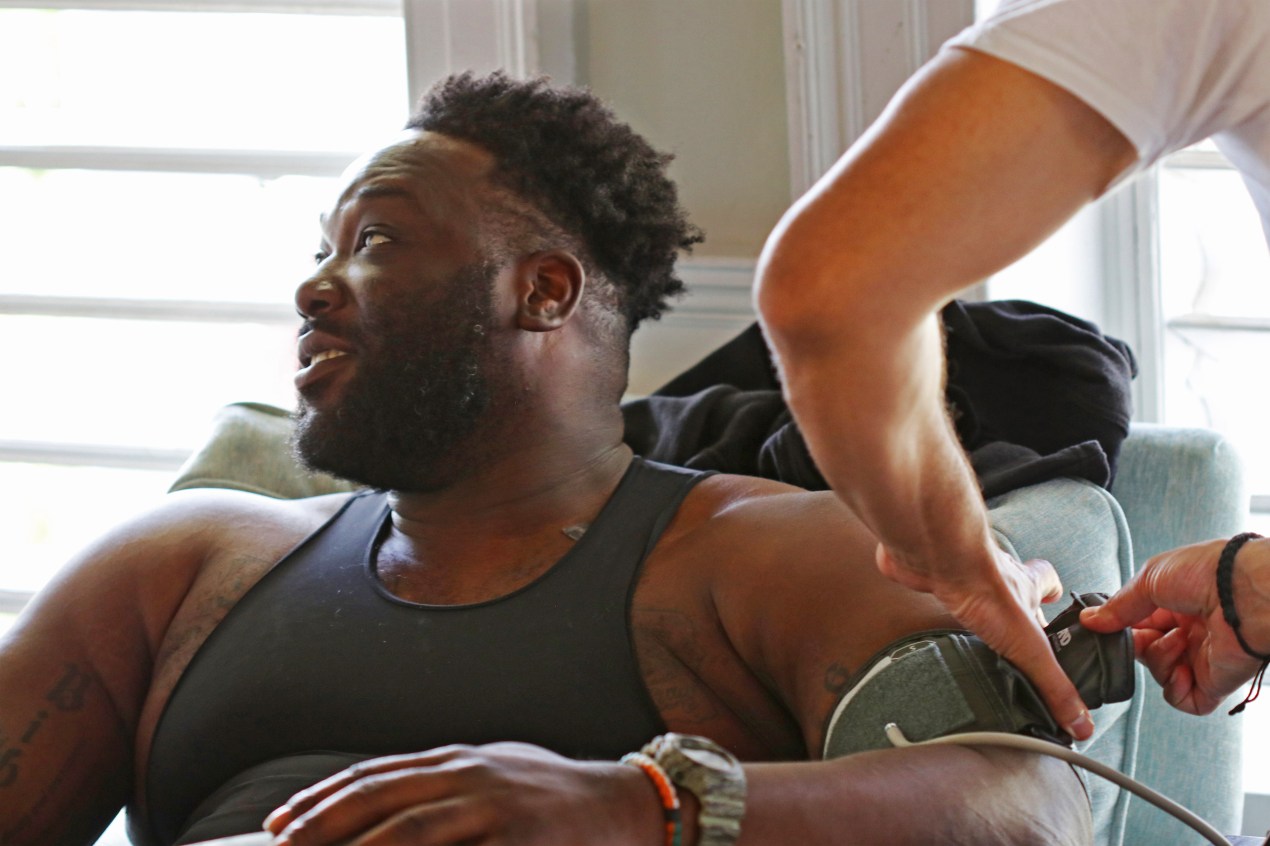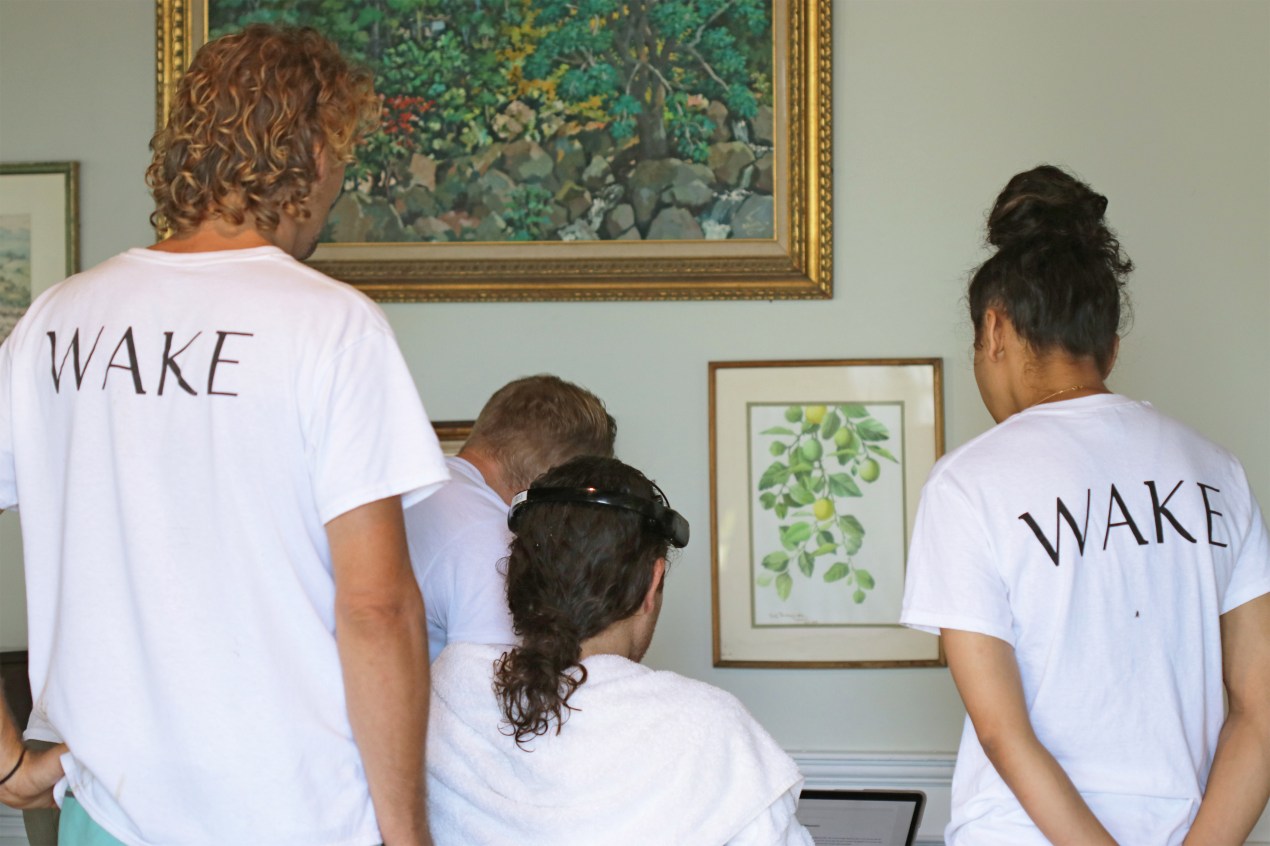WAKEFIELD, Jamaica — El boxeador se sentía destrozado. Todos los días, se despertaba con dolor. A veces eran dolores de cabeza debilitantes. Otros, era su espalda. O sus puños. Sus costillas. Su nariz. Además, sufría de cambios de humor. Depresión. Ansiedad.
Mike Lee no se arrepintió de su carrera. Había sido uno de los mejores boxeadores profesionales del mundo en su categoría. Tenía marca de 21-1, y peleó en el Madison Square Garden y frente a millones en la televisión.
Pero habían pasado más de dos años desde que pisó un ring, y cada día era un recordatorio del costo. En un momento, Lee estaba tomando ocho medicamentos recetados, todos para tratar de sobrellevar la situación.
Contó que, en su momento más bajo, en una noche en que estaba en lo más profundo de una adicción a los analgésicos, pensó en chocar su auto contra la valla de una autopista de Chicago a 140 mph.
Estaba dispuesto a hacer cualquier cosa para escapar del infierno en el que se sentía atrapado.
El impulso se desvaneció, pero el dolor permaneció.
Estaba perdido.
“Cuando tienes dolor y estás atrapado, harás cualquier cosa para salir de eso”, dijo Lee.
Ahora, había llegado a una jungla verde al final de un camino de tierra en la mitad de una montaña.
Esperaba que los hongos psicodélicos pudieran cambiar su vida.
Lee era parte de un pequeño grupo, muchos de ellos atletas retirados, que viajaron a Jamaica en marzo de 2022 para un retiro que costó hasta $5500. Cada uno de ellos había venido a Good Hope Estate, una plantación de azúcar convertida en centro turístico exclusivo, con la esperanza de librarse de la depresión, la ansiedad y el dolor crónico que habían experimentado durante años.
Dos ceremonias con hongos psicodélicos y dos sesiones de terapia les esperaban en el retiro dirigido por una empresa canadiense llamada Wake Network. Los participantes estaban nerviosos, pero también esperanzados.
Junto con Lee, había un jugador profesional de fútbol americano que estaba considerando retirarse y una ex estrella de hockey que tenía múltiples conmociones cerebrales.
Venían de todas partes de América del Norte, de diferentes orígenes y diferentes deportes, pero tenían algunas cosas en común: eran vulnerables y sentían que los medicamentos recetados les habían fallado. No sabían qué esperar, si el tratamiento funcionaría, si regresarían a casa con una solución o simplemente con otra decepción.
Lee se enteró del retiro por un amigo de la infancia que trabaja como médico en Wake. Otros habían sido reclutados por Riley Cote, un ex ejecutor de los Philadelphia Flyers y ahora un evangelista psicodélico que es asesor de Wake con una participación accionaria.
Alguna vez, Cote fue como Lee. Le encantaba golpear a la gente en la cara. Amaba la forma en que su mano aterrizaba con un ruido sordo cuando sus nudillos se conectaban con la carne y el hueso a una velocidad violenta. Romper la cabeza de alguien hacía que Cote se sintiera vivo.
“Luché contra todos. Escogía al tipo más grande que pudiera encontrar y lo desafiaba. Así fue como sobreviví, cómo me hice un nombre. Me estaba infligiendo todo este dolor e inflamación, siempre recibiendo puñetazos en la cara, y tenía que mantener este tipo de personalidad machista, como, ‘Oh, no puedes lastimarme. No puedes lastimarme’”.
Ya no era esa persona. Le daba escalofríos pensar en el hombre que alguna vez fue, alguien que bebía en exceso y usaba analgésicos para adormecer su cerebro. Hubo un tiempo en que él, como Lee, estaba en un lugar oscuro, pero con el transcurso de varios años, los hongos psicodélicos, cree Cote, lo ayudaron a regresar a la luz.
“El mundo está en una crisis, una crisis de salud mental, una crisis espiritual”, dijo Cote. “Y creo que estas son medicinas espirituales, y siento que es el camino correcto para mí. No lo considero más que mi deber, mi propósito en este planeta es compartir la verdad sobre la medicina natural”.
Durante años, han circulado rumores sobre una red clandestina de atletas, principalmente ex atletas, que usan psilocibina, el compuesto de los hongos mágicos, para tratar lesiones cerebrales traumáticas, ansiedad y depresión.
Muchos de ellos, como Cote, ven a los psicodélicos como una cura milagrosa, lo único que pudieron encontrar que podría ayudar a romper un ciclo de analgésicos y abuso de sustancias. Se reunían en pequeños grupos para ingerir hongos en privado o viajaban a países como Jamaica donde los hongos psicodélicos no están prohibidos.
Ahora, el uso de hongos psicodélicos está ganando terreno en los Estados Unidos. Varias ciudades han despenalizado la posesión de psilocibina, y los votantes de Oregon y Colorado aprobaron medidas electorales para legalizar los hongos mágicos bajo uso supervisado. Muchos investigadores predicen que la Administración de Drogas y Alimentos (FDA) aprobará un tratamiento psicodélico en los próximos cinco años.
Pero muchos de esos mismos investigadores advierten que la intensa promoción de los psicodélicos está superando a la ciencia, y que el tratamiento conlleva riesgos significativos para algunos pacientes. Temen que, a menos que la investigación se lleve a cabo de forma metódica y ética, el uso generalizado de la psilocibina podría resultar en una reacción negativa del público, como sucedió en la década de 1960, relegando un tratamiento prometedor al basurero de las sustancias prohibidas.
Están instando a las entidades corporativas como Wake, que ya se están posicionando para aprovechar la posible legalización de los psicodélicos, a que avancen lentamente, se aseguren de que la investigación se realice de la manera correcta y permitan que la ciencia se ponga al día.
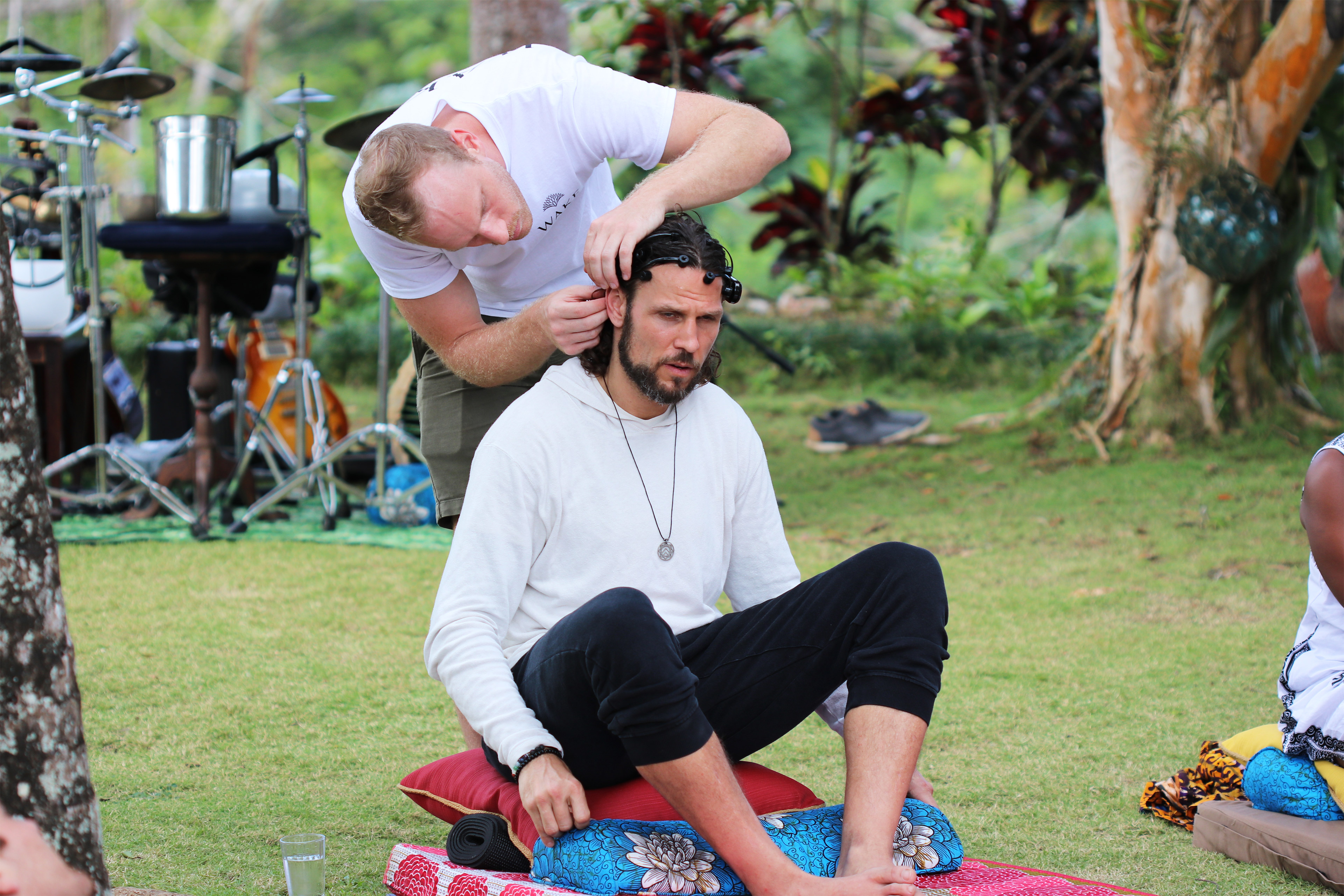
“Si no haces esto de manera segura, la gente saldrá lastimada”, dijo Matthew Johnson, profesor de psiquiatría e investigador de psicodélicos en la Universidad Johns Hopkins.
Pero muchos, incluidos los ex atletas profesionales con cuerpos y cerebros maltratados, no quieren esperar el lento avance de la investigación clínica. Necesitan ayuda ahora.
Los analgésicos, los antidepresivos, las innumerables píldoras diferentes que les recetaron a lo largo de los años no han ayudado. En sus mentes, las historias de sus compañeros atletas que dicen que se han beneficiado de los psicodélicos superan cualquier incertidumbre científica.
“Cuando piensas en hongos mágicos, piensas en los hippies de Woodstock bailando al ritmo de la música”, dijo Lee. “Pensar que tienes algunos de los mejores atletas del mundo aquí que están lidiando con algunas cosas y las están tomando, te hace sentir más cómodo. Me hace sentir como, ‘Está bien, tal vez estoy haciendo lo correcto’. Es una medicina curativa; no es solo una droga de fiesta”.
***
Cote, ahora de 41 años, era un patinador de hockey decente que creció en Winnipeg, Manitoba, tenaz de punta a punta y un trabajador incansable, pero bastante promedio en el manejo del disco.
No anotó suficientes goles para ascender en el hockey junior como lo hicieron algunos prospectos. Sin embargo, a medida que crecía, a los entrenadores no les importaba tanto. Tenía hombros anchos y un largo alcance. En una era del hockey en la cual la violencia todavía era moneda corriente, había encontrado su boleto dorado para la NHL: Cote golpeaba a la gente y recibía golpes a cambio.
Como miembro de los Flyers, vio que era su deber mantener las tradiciones de los Broad Street Bullies, un grupo de jugadores de la década de 1970 que fueron celebrados por la prensa por jugar y festejar fuerte.
Se abrió camino a través de la NHL durante partes de cuatro temporadas, acumulando más de 400 minutos de penalización en su carrera y anotando solo un gol. La mayoría de sus peleas fueron situaciones brutales, bárbaras. Sus destacados muestran a un gigante corpulento, con los ojos llenos de violencia, el tipo de matón que podría romperte la mandíbula y reír como un maníaco después, la sangre goteando de su rostro y cayendo al hielo.
“Fue algo que disfruté hacer, y creo que era solo un elemento de competencia para mí”, dijo Cote. “Y probablemente también era algo que estaba haciendo por miedo: miedo de no vivir mi sueño de la infancia o de decepcionar a mis padres o a la gente”.
Dijo que se medicaba por su dolor casi todos los días con alcohol. Las cervezas eran un aperitivo de camino a los shots en la barra. Después, venían drogas duras. Él y sus compañeros de equipo se quedaban fuera hasta las 3 am, a veces más tarde, y luego intentaban sudar el veneno al día siguiente durante la práctica.
Después de unos años, su cerebro comenzó a empañarse. Se hizo más grande y más fuerte a través del levantamiento de pesas, y parecía un monstruo en el hielo, pero cada una de sus habilidades de hockey se deterioró, salvo las peleas. A medida que su carrera terminaba, dijo, se sentía como si la oscuridad se acercara sigilosamente. Se deprimió. Tenía miedo de en lo que se había convertido.
Hoy, Cote se parece poco a aquel ejecutor de los videos. Más delgado y tranquilo, imparte clases de yoga en un estudio de Delaware tres veces por semana. Con el pelo hasta los hombros, tatuajes en los brazos y el pecho, habla con una suave voz de barítono. Parece más un monje que un monstruo.
“Miro hacia atrás y tal vez solo muestra lo confundido que estaba y la realidad que estaba buscando, que supuestamente era la felicidad y la satisfacción de perseguir el sueño de mi infancia”, dijo Cote. “Pero es difícil para mí entender que estoy haciendo eso ahora, simplemente sabiendo quién soy ahora y dándome cuenta de que se necesita mucha oscuridad para hacer lo que hice”.
Cote dijo que tomó hongos de forma recreativa durante sus 20 años, pero nunca en un entorno terapéutico o con el entendimiento de que podrían ayudarlo a procesar su trauma físico y emocional. “Era solo parte de la escena o parte de la fiesta”, dijo.
Pero cuando se jubiló en 2010, sintió que estaba enfrentando una crisis de identidad. Había sido un luchador durante tanto tiempo que pensó que eso era todo lo que era. ¿Cómo podría un ejecutor fracasado criar a dos hijas?
Empezó a leer. Lo que aprendió lo sorprendió.
Los investigadores habían revivido silenciosamente el estudio sobre los hongos psicodélicos como tratamiento médico en el año 2000, y los primeros hallazgos sugirieron que la psilocibina a menudo tenía beneficios notables para las personas diagnosticadas con ansiedad y depresión. Ayudó a algunos pacientes a deshacerse de sus adicciones a las drogas o al alcohol.
Otra investigación sugirió que la psilocibina en realidad puede ser capaz de remodelar la anatomía del cerebro, restaurar las vías neurológicas y ayudar a curar lesiones cerebrales traumáticas.
Para Cote, a quien le diagnosticaron al menos tres conmociones cerebrales en su carrera de hockey y probablemente sufrió muchas más, fue transformador.
Cote ahora recluta clientes para Wake, que organiza retiros inmersivos de psilocibina fuera de los Estados Unidos.
“Algunas personas vienen a estos eventos y están al borde del suicidio”, dijo Tyler Macleod, cofundador de Wake y su director de experiencia. “No se arreglan después de una ceremonia, pero ya no están atascados en la oscuridad. Se despiertan y dicen: ‘Oh, puedo navegar de nuevo una relación con mis hijos'”.
Todos los ex atletas que asisten a estos retiros están luchando con algo, dijo Cote. Necesitan ayuda. En muchos casos, sienten que han probado todo lo demás. Les pregunta por qué tienen que esperar cuando tantos estudios y anécdotas indican resultados positivos.

“Es como con el cannabis: ¿cuántas historias tuvimos que contarnos antes de tener un programa médico?”, apuntó Cote. “Simplemente ha estado bloqueado durante tanto tiempo”.
***
En 1970, el presidente Richard Nixon promulgó la Ley de Sustancias Controladas, legislación que dividía las drogas en cinco niveles, clasificándolas en gran medida según su potencial de abuso. Los hongos mágicos se clasificaron como sustancias de la Lista 1, junto con la heroína y la marihuana, lo que significa que el gobierno creía que no tenían ningún beneficio médico y que tenían un alto potencial de generar adicción. (La cocaína, la oxicodona y la metanfetamina se clasificaron como drogas de la Lista 2).
Esas decisiones, que el asesor de Nixon, John Ehrlichman, dijo más tarde que tenían motivaciones políticas, continúan teniendo un efecto dominó en la actualidad. La investigación sobre tratamientos psicodélicos se suspendió durante 30 años.
Si bien los estudios recientes han tenido un alcance pequeño, han mostrado efectos notables. Los medicamentos recetados aprobados para afecciones como la ansiedad o la depresión ayudan, en el mejor de los casos, a entre el 40% y el 60% de los pacientes. En los primeros ensayos, los psicodélicos han alcanzado tasas de eficacia de más del 70%.
Y, a diferencia de la mayoría de los medicamentos recetados, que dejan de funcionar poco después de que los pacientes dejan de tomarlos, uno o dos tratamientos de psilocibina pueden tener efectos terapéuticos por seis meses, un año o incluso más, según un estudio de Johns Hopkins.
Con un riesgo mínimo de adicción o sobredosis y siglos de uso por parte de las culturas indígenas, muchos investigadores consideran que la psilocibina es un tratamiento innovador potencial con grandes beneficios y pocos riesgos.
Scott Aaronson, director de programas de investigación clínica en Sheppard Pratt, un hospital psiquiátrico sin fines de lucro en las afueras de Baltimore, ha estado estudiando los trastornos del estado de ánimo difíciles de tratar durante 40 años, comenzando con algunos de los primeros estudios sobre Prozac.
“Soy un ser humano cínico, escéptico y sarcástico”, dijo Aaronson. “Y te diré, nunca he visto algo así en todos mis años”.
Pero la psilocibina no está exenta de riesgos. Puede exacerbar problemas cardíacos y desencadenar esquizofrenia en personas con una predisposición genética, y la combinación de psilocibina y litio puede causar convulsiones.
Los ensayos clínicos generalmente han descartado a los pacientes en riesgo de tales complicaciones. Aún así, una parte significativa de quienes consumen psilocibina, incluso sin ninguna de esas preocupaciones, tienen una experiencia negativa.
“En una dosis alta, alrededor de un tercio de las personas en nuestros estudios, incluso en estas condiciones ideales, pueden tener lo que se llamaría un mal viaje, algún grado de ansiedad o miedo sustancial”, dijo Johnson, investigador de Johns Hopkins. “Una persona puede ser muy vulnerable psicológicamente. Puede sentirse como si estuvieran muriendo”.
Sin embargo, a veces, incluso esos “malos viajes” pueden conducir a la ayuda con la depresión u otros problemas, según han descubierto investigadores, especialmente con la ayuda de seguimiento de un terapeuta para procesar la experiencia.
Los efectos psicodélicos de la psilocibina también pueden desconectar a una persona de la realidad, lo que puede llevar a las personas a hacer cosas peligrosas, como correr hacia el tráfico o saltar por una ventana.
“La percepción misma de la realidad y de ellos mismos en la realidad, como quiénes son, estas cosas pueden cambiar profundamente y no es una buena receta para interactuar en público”, dijo Johnson.
Los investigadores también describen casos en los que la psilocibina pone a las personas con problemas psicológicos no resueltos en estado de angustia a largo plazo.
Es por eso que los investigadores insisten en que la psilocibina debe administrarse en un entorno clínico con terapeutas capacitados que puedan guiar a las personas a través de la experiencia, lidiar con los resultados negativos cuando surjan, y ayudarlas a procesar e integrar sus experiencias.
Los ensayos clínicos de psilocibina se han basado en protocolos estrictos, que incluyen una o más sesiones antes del tratamiento para ayudar a los participantes a comprender qué esperar. El consumo de los hongos se hace a menudo en un solo día, con uno o dos terapeutas disponibles.
En los días siguientes, la persona regresa para lo que se conoce como integración, generalmente una sesión de terapia individual para ayudar a procesar la experiencia y comenzar el camino hacia la curación. Algunos ensayos agregan un día adicional de terapia entre dos tratamientos.
A diferencia de un medicamento típico, nose envía a los pacientes a casa con un frasco de píldoras. Todo el protocolo se parece más a un procedimiento médico.
Pero es un error pensar que es la medicina psicodélica la que hace todo el trabajo, no la terapia que viene después, dijo Jeffrey LaPratt, psicólogo e investigador de psilocibina con Sheppard Pratt. “Es un trabajo muy duro y requiere vulnerabilidad. Se necesita coraje. Puede ser realmente doloroso”.
***
El ex jugador de la NHL Steve Downie sintió como si algo en él se hubiera roto cuando lo invitaron al retiro de Wake en Jamaica. Sus días estaban llenos de niebla. Vivía con depresión, a menudo incapaz de salir de su casa.
“Me cansé de ir a esos médicos y me cansé de hablar con ellos”, dijo Downie. “No me malinterpreten, no digo que los médicos sean malos. Solo digo que, en mi experiencia personal, lo que viví no fue positivo. Y llega un punto en el que tienes que probar algo nuevo, y es por eso que estoy aquí”.
También tuvo un trauma en su vida que nunca había enfrentado realmente. Cuando Downie tenía 8 años, su padre murió en un accidente automovilístico que lo llevó a practicar hockey. Lanzarse profundamente en el deporte fue su única forma de sobrellevar la muerte de su padre. Al igual que Cote, su compañero de equipo en los Flyers durante dos años, jugó de manera imprudente imprudente, lanzándose a colisiones violentas que lo dejaban a él y a sus oponentes ensangrentados.

Después de una carrera juvenil empañada por una controversia de novatos, Downie comenzó su primera temporada en la NHL, en 2007, con una suspensión de 20 juegos por un brutal control en las tablas en un competencia de pretemporada que envió a su oponente fuera del hielo en camilla.
Sigue siendo una de las suspensiones más largas jamás emitidas por la liga. En la prensa de hockey, fue etiquetado como un villano, un matón y un psicótico extremo. Las palabras le dolieron un poco, incluso cuando trató de reírse de ellas.
“No tengo dientes y soy pequeño, así que no pueden estar tan equivocados”, dijo Downie. “¿Bien? Al final del día, era un trabajo. Hice lo que me pidieron”.
Durante sus nueve temporadas jugando para cinco equipos de la NHL, sufrió más conmociones cerebrales de las que podía recordar. Sordo de un oído, al borde de las lágrimas todos los días y bastante seguro de que estaba bebiendo demasiado, Downie, que ahora tiene 36 años, se miraba en el espejo algunos días y se preguntaba si estaría muerto en seis meses.
No sabía nada sobre psicodélicos, solo que Cote le había dicho que lo ayudaría cuando Downie estuviera listo.
“Llamé a Riley y le dije: ‘Necesito algo, hombre’. Me cansé de ir a los médicos y hablar con ellos”, dijo Downie. “Muchas de las pastillas que te dan, te comen el cerebro. Realmente no te ayudan”.
Justin Renfrow, un jugador de línea de 33 años que jugó en la NFL y en Canadá, llegó en busca de claridad. Estaba considerando retirarse del fútbol profesional, algo que lo asustaba y lo emocionaba. Había estado jugando durante la mitad de su vida, y el juego era una gran parte de su identidad. Fue la última conexión que tuvo con su abuela, una de las personas más importantes de su vida. Ella fue la que iba a los viajes de reclutamiento con él. Después de su muerte en 2021, Renfrow sintió que una parte de ella todavía estaba con él mientras jugara.
Pero después de una década de jugar profesionalmente, el cuerpo de Renfrow estaba maltratado. Le dolía una de las rodillas. Había llegado a odiar las drogas farmacéuticas. Dijo que los médicos del equipo le habían recetado tantos medicamentos diferentes, incluidos los que cubren el estómago y los bloqueadores de los nervios para que pudiera tomar más analgésicos, que su cuerpo comenzó a experimentar terribles efectos secundarios.
Dijo que una vez tuvo una reacción tan mala a una combinación de analgésicos que le habían dado que necesitó atención médica después de sudar a través de su ropa y tener problemas para respirar.
“Es solo, ‘Necesitamos llegar a los playoffs, así que toma esto'”, dijo Renfrow. “Lanzó mi cuerpo en picada”.
Había usado hongos psicodélicos en numerosas ocasiones, principalmente como una forma de lidiar con el dolor provocado por el fútbol americano, pero nunca los había usado como parte de una ceremonia o para meditar. En este viaje, buscó claridad. ¿Era hora de alejarse del fútbol? Le apasionaba la cocina y estaba pensando en iniciar su propio programa en YouTube. Tal vez era hora de cambiar su enfoque y dejar que el fútbol se desvaneciera.
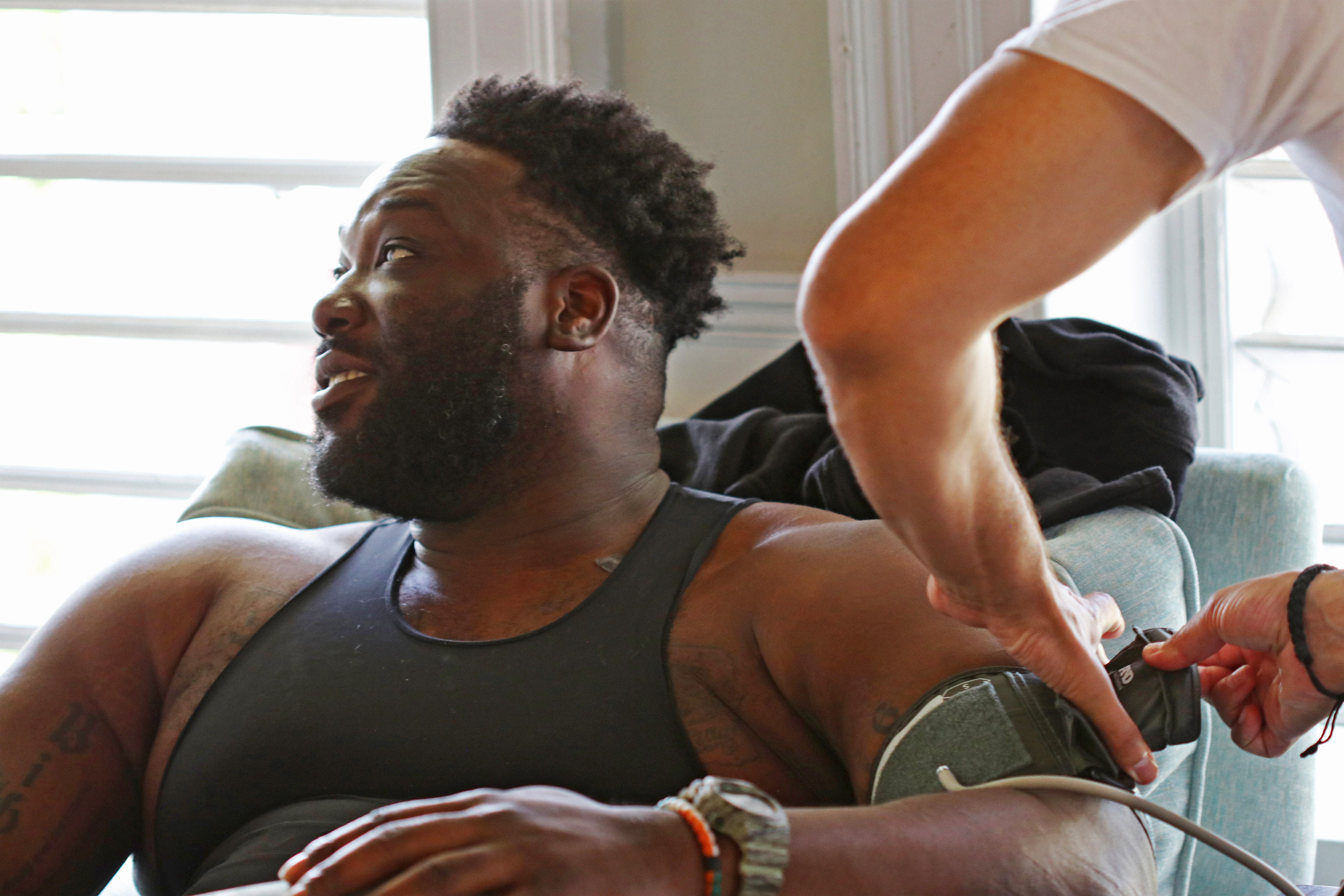
“Tengo muchas personas que dependen de mí todos los días”, dijo Renfrow.
Los atletas esperaban que la ceremonia los ayudara a obtener respuestas.
La investigación sobre psicodélicos es prometedora y emocionante, pero la efectividad de los hongos como tratamiento no está del todo establecida. Pero incluso si la psilocibina y otros psicodélicos resultan ser nada más que un placebo, lo que algunos investigadores dicen que es posible, muchos atletas juran que están encontrando un alivio real de la ansiedad, la depresión y otros traumas persistentes de sus días de juego.
Con un mercado global potencial multimillonario, también hay un gran incentivo financiero. Wake es solo una de un número creciente de nuevas empresas con fines de lucro respaldadas por dinero de inversión privada que buscan una parte del tratamiento psicodélico.
Eventualmente, ellos y otros esperan abrir centros de tratamiento o vender las drogas en los Estados Unidos y Canadá. En Canadá, la producción, venta o posesión de hongos psicodélicos son ilegales.
Durante el retiro de Jamaica, los líderes de Wake dieron una presentación a los participantes sobre cómo podrían invertir en la empresa.
Macleod dijo que se interesó en la terapia psicodélica no como una oportunidad comercial, sino después de que perdió a su hermana, Heather, hace seis años por suicidio.
Perderla lo llevó a buscar respuestas. Su hermana había sido esquiadora competitiva en Canadá, pero una serie de caídas le provocaron múltiples conmociones cerebrales y durante su vida adulta tuvo ansiedad y depresión. La medicina tradicional le falló repetidamente, dijo Macleod. Cada semana, se encuentra deseando haber sabido lo que sabe ahora y haberlo usado para intentar salvarla.
“No puedo decirte cuántas personas vienen a mí que están luchando como mi hermana”, dijo. “Dios, desearía que ella pudiera estar aquí. Sé que ella nos estaría animando. La veo a veces mirándonos desde arriba y diciendo: ‘Ayuda a otras personas que estaban atrapadas donde yo estaba'”.
Ansiosas por llevar los tratamientos psicodélicos a los consumidores, las empresas corporativas a menudo extrapolan los resultados de la investigación de ensayos clínicos estrictamente controlados con pacientes cuidadosamente seleccionados para promover un uso más amplio por parte de la población general en casi cualquier entorno.
“La presión por los psicodélicos generalmente está siendo impulsada por personas que quieren ganar dinero, mucho más que por científicos”, dijo Kevin Sabet, ex asesor principal de la Oficina de Política Nacional de Control de Drogas de la Casa Blanca, y ahora presidente y director ejecutivo de Smart Approaches to Marijuana, un grupo político que se opone a la legalización de la marihuana.
“¿Por qué dejaríamos que los inversionistas de Wall Street, que son realmente los que están aquí tratando de ganar dinero, lideren la conversación?”, agregó.
La comercialización podría ser tanto buena como mala para los psicodélicos. Por un lado, podría proporcionar financiación para la investigación; por otro, el deseo de rentabilizar esa inversión podría influir indebidamente en los resultados y poner en riesgo a los pacientes.
“Tu modelo de negocio no va a funcionar bien cuando alguien salta por la ventana y aparece en la portada de The New York Times”, dijo Johnson, el investigador de Johns Hopkins.
La investigación clínica también debe superar la imagen del hongo como una droga de fiesta, algo que los hippies comparten en bolsas de plástico en las últimas filas de los conciertos.
Para cambiar esa narrativa, dicen Wake y otras compañías, se están inclinando mucho hacia la ciencia. Esto no es una búsqueda de emociones, dicen, sino una medicina legítima que trata condiciones psiquiátricas reales.
Es el mismo argumento que hicieron los defensores de la legalización de la marihuana, ya sea que lo creyeran o lo estuvieran usando como un medio para un fin: presionar para legalizar el cannabis como medicina antes de abrir las puertas al uso recreativo sin restricciones.
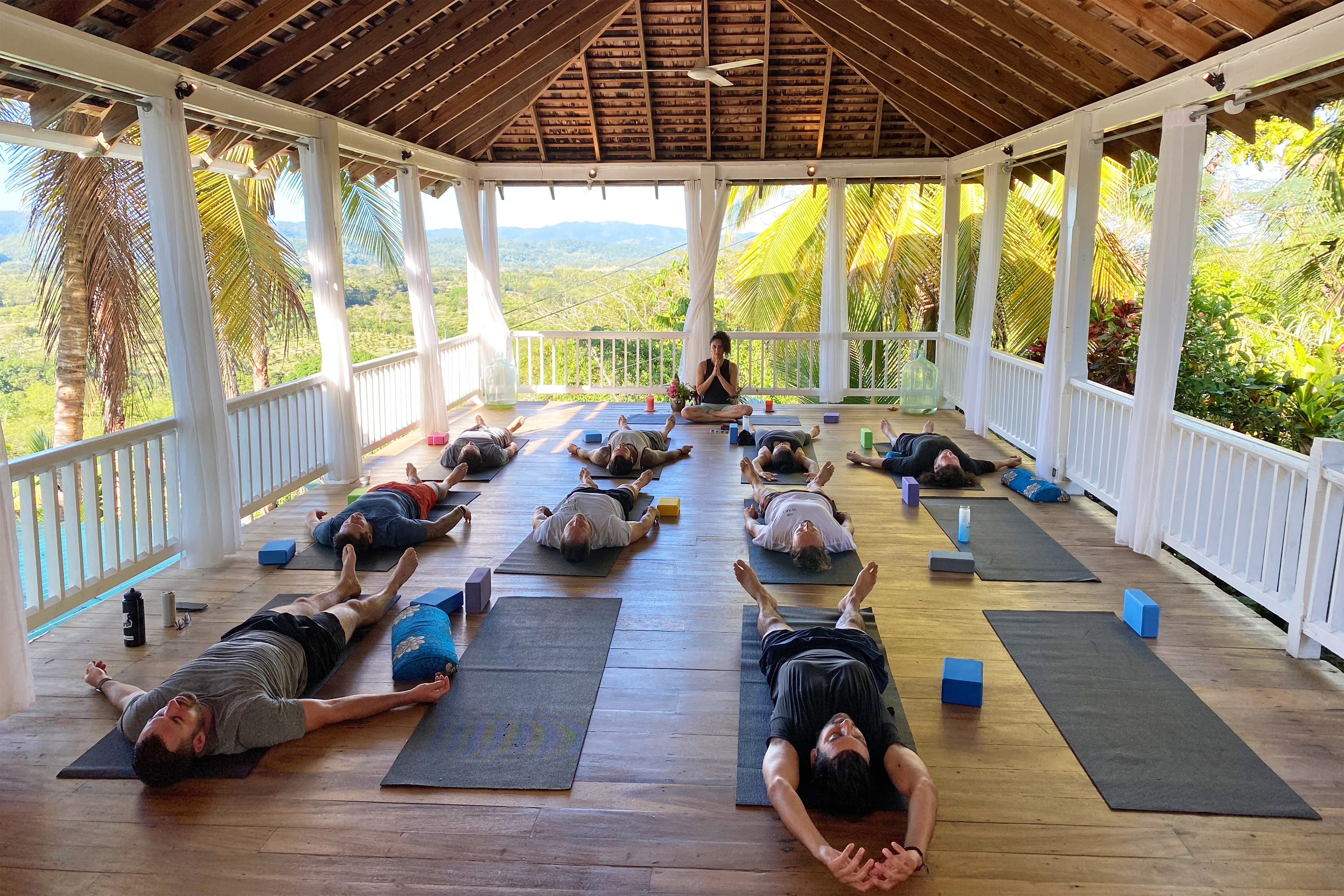
Los líderes de Wake, como la mayoría de los ejecutivos en el universo psicodélico, han dicho que están comprometidos a ayudar en la investigación para demostrar a los reguladores federales que la psilocibina es segura y efectiva. Las muestras de sangre y saliva que recolectó un médico en el retiro de Wake, dijeron, se usarían para identificar marcadores genéticos que podrían predecir quién responderá al tratamiento con psilocibina.
El equipo de Wake hizo que los participantes usaran un casco que contenía tecnología de imágenes experimentales que se había utilizado en ensayos clínicos para rastrear la actividad cerebral antes, durante y después de las experiencias psicodélicas. Como parte de la investigación, los participantes usaron el casco mientras jugaban juegos de palabras.
Muchos investigadores académicos se preguntan si algunas empresas simplemente están aplicando un barniz de ciencia a un esfuerzo por hacer dinero, lo que muchos escépticos denominan “teatro placebo”.
De hecho, Aaronson teme que el campo pronto pueda estar “lleno de vendedores ambulantes”.
“El problema que tienes es que, como era de esperar, las redes sociales y las comunicaciones funcionan mucho más rápido que la ciencia”, dijo. “Entonces, todos están tratando de tener en sus manos estas cosas porque creen que será increíble”.
Aaronson ha diseñado protocolos de ensayos clínicos para Compass Pathways, una empresa competidora con fines de lucro que busca comercializar tratamientos con psilocibina, y ha rechazado a otras empresas que buscan crear una huella en el espacio psicodélico. (Aaronson recibe fondos de Compass para respaldar su investigación, pero dijo que no tiene ningún interés financiero directo en la empresa).
“Me preocupa quién respalda el juego de algunas de estas compañías y trato de averiguar qué es lo que realmente busca alguien”, dijo. “Hablas con la gente y ves si hay un plan real para investigar o si hay un plan real para vender algo”.
***
Un murmullo de tensión nerviosa perduraba en el aire mientras los atletas se preparaban para la ceremonia. En el desayuno, no hubo muchas conversaciones triviales. Los asistentes se arremolinaron y se registraron con el personal médico de Wake para ofrecer sus muestras de sangre y saliva. Algunos participaron en una clase de yoga en un estudio al aire libre con vista a la jungla.
Wake había contratado a una chamán jamaicana, una mujer llamada Sherece Cowan, una empresaria de comida vegana que fue finalista de Miss Universe Jamaica 2012, para dirigir a los atletas en la ceremonia. Pidió que la llamaran Sita y se refirió a sí misma como facilitadora de medicina natural.
Habló lenta y deliberadamente, agitando el humo de una urna mientras instaba a los participantes a reunirse en círculo en el césped de la finca. Después de beber una dosis de 3 a 5 gramos de psilocibina, que había sido molida en polvo y mezclada con jugo de naranja, los atletas cayeron en un estado de sueño durante las próximas cuatro a seis horas.
“Espero que obtengas todo lo que necesitas. Puede que no sea todo lo que estás pidiendo, pero espero que recibas todo lo que necesitas”, dijo Cowan. “Bendiciones en tu viaje”.
Un músico local comenzó a tocar, sus tambores y campanas pretendían realzar el viaje. La mayoría de los atletas yacían sobre colchonetas, como si durmieran. Cote se sentó en una pose de yoga. Nick Murray, director ejecutivo de Wake, le había pedido a Cote que usara un casco especial, un dispositivo de electroencefalografía más pequeño que el otro casco, para medir su actividad cerebral.
Excepto por los tambores y las campanas del músico, todo estaba en silencio. De vez en cuando, el viento agitaba las hojas de los árboles en el límite de la propiedad, pero durante las siguientes seis horas, dentro del círculo, el tiempo casi se detuvo.
Dos horas después de la ceremonia, después de que el psicodélico había hecho efecto, lo que estaba ocurriendo pasaba dentro de las cabezas de los atletas. Cote, sorprendentemente, seguía manteniendo su postura de yoga.
El silencio se rompió cuando Renfrow se levantó de su estera después de tres horas. Llevaba una sudadera en la ceremonia con sus iniciales, JR, estampadas en el pecho. Se quitó la camisa de su cuerpo con frustración y la arrojó a un lado.
Las lágrimas se derramaron por su rostro.
Cuando la ceremonia terminó, los atletas comenzaron a sentarse y algunos charlaron en voz baja.
La mayoría no estaba seguro de cómo describir la experiencia. Para algunos, se sintió como un descenso a los rincones de la mente, con colores y emociones mezclándose. Otros dijeron que enfrentaron traumas que pensaron que habían enterrado o emociones que querían reprimir. Dijeron sentir una conexión con las otras personas en el círculo.
“Es el último asesino del ego porque, al menos para mí, te da una empatía increíble que nunca antes habías sentido”, dijo Lee. “Cuando estás haciendo un viaje con otras personas, te ves a tí mismo en ellos. Es casi como si estuvieras caminando frente a un espejo, diferentes espejos. Ves partes de tí mismo en todos y te das cuenta de que todos estamos conectados y todos estamos pasando por algo, todos tenemos algún tipo de dolor, y eso te vuelve humilde”.
La mayoría de los atletas se quedaron solos para poder anotar sus pensamientos en un diario, siguiendo las instrucciones del personal de Wake. Habría una sesión de terapia comunitaria a la mañana siguiente.
A cada uno se le pediría que compartiera algo de su viaje.
***
Al final, la mayoría de los curiosos sobre la psilocibina simplemente quieren saber: ¿Funciona? Y, ¿cómo funciona? Los científicos dicen que esas son preguntas difíciles de responder en este momento.
Investigadores han descubierto que los psicodélicos clásicos, como la psilocibina y el LSD, actúan sobre el receptor de serotonina 2A, el mismo receptor al que se apuntan los antidepresivos más comunes del mercado. Pero más allá de eso, la comprensión de cómo funcionan para ayudar a las personas es, en este punto, más teoría o conjetura que hecho científico.
Johnson, el investigador de Johns Hopkins, dijo que la psilocibina ayuda a aumentar la apertura en las personas, permitiéndoles salir de su visión de quiénes son. Alguien que se resigna a ser un fumador que no puede dejar de fumar o una persona con depresión que no puede encontrar la felicidad puede, bajo la influencia de los psicodélicos, verse a sí mismo de una manera diferente, explicó.
“Una vez que están fuera de la trampa mental, se vuelve tan obvio para las personas con estos diferentes trastornos que, ‘¿Sabes qué? Puedo simplemente decidir dejar de fumar. Puedo dejar de lado mi tristeza’”, dijo Johnson.
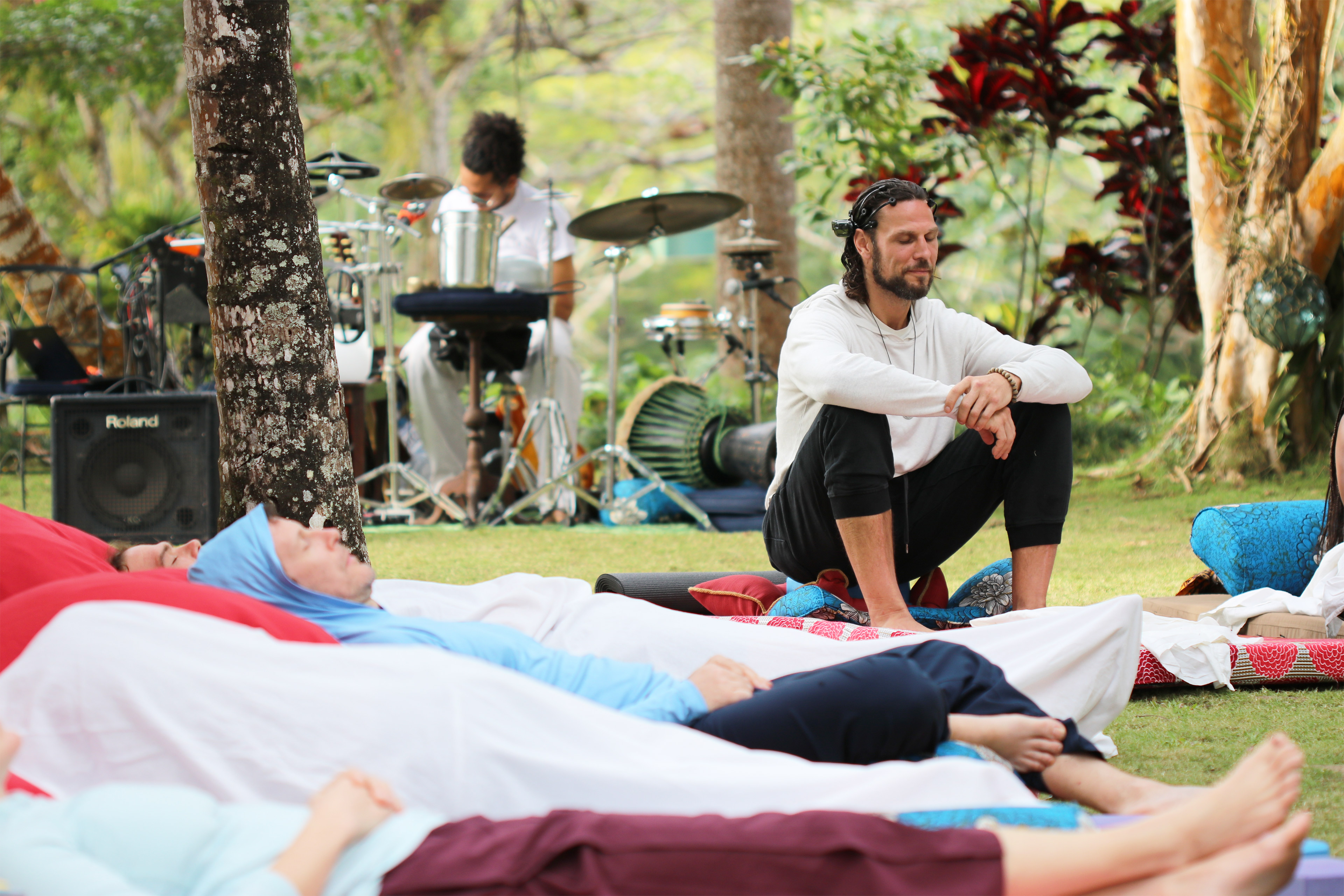
Estudios con ratas muestran que los psicodélicos también parecen aumentar la conectividad neuronal en el cerebro, incluso después de una sola dosis. Eso podría ayudar al cerebro a recuperarse de lesiones traumáticas o conmociones cerebrales, encontrando nuevos caminos alrededor de las áreas dañadas.
La teoría predominante de cómo la psilocibina y otros psicodélicos podrían ayudar a tratar la salud mental es que reprimen la actividad en la red de modo predeterminado del cerebro. Es un conjunto de regiones del cerebro que se activan cuando las personas reflexionan sobre algo, y una de las pocas partes que está hiperactiva en las personas con depresión.
A menudo revisan los errores que cometieron una y otra vez o se castigan continuamente por ellos, dijo LaPratt, el investigador de Sheppard Pratt. Esa hiperactividad en la red de modo predeterminado conduce a patrones repetitivos de pensamientos negativos. ¿Qué me pasa? ¿Por qué soy tan infeliz? De los cuales la persona no puede escapar.
Las personas con depresión suelen reflexionar sobre el pasado; personas con ansiedad, sobre el futuro.
“Es posible que surja algo y luego el cerebro comience a pensar, y nuevamente, como ese disco rayado”, dijo LaPratt. “Puede ser muy fácil comenzar a pensar en cómo todo podría salir mal y comenzar a dramatizar”.
Ese pensamiento repetitivo también prevalece en personas con otras afecciones, incluido el trastorno obsesivo compulsivo y el trastorno por estrés postraumático. Comienza a afectar el sentido de quiénes son; se definen a sí mismos por su condición.
Pero los psicodélicos parecen ayudar a las personas a examinar viejos traumas sin volver a caer en el mismo ciclo destructivo. Pueden ayudar a las personas a sentirse más conectadas con los demás. La depresión y la ansiedad no se borran simplemente, dijo LaPratt, sino que las personas pueden obtener una nueva perspectiva de sus problemas y comenzar a sentir, tal vez por primera vez, que pueden deshacerse de ellos.
“Vemos una mayor apertura y cierta motivación para cambiar los comportamientos”, dijo.
La mayoría de los psicodélicos están fuera del sistema de una persona a la mañana siguiente, pero, según los investigadores, esa mayor apertura puede durar semanas o meses sin dosis adicionales, lo que brinda una ventana durante la cual pueden comenzar a abordar sus problemas.
“Quizás estemos ayudando a las personas a llegar al punto de poder aceptar las cosas que no pueden cambiar y cambiar las cosas que sí pueden”, dijo Aaronson, haciéndose eco de la Oración de la serenidad, que a menudo se usa en los ejercicios de 12 pasos de los programas de recuperación. “Se les quita autonomía personal a las personas con depresión. No sienten que puedan operar en su mejor interés. Se ven atrapados en un conflicto interno. Y creo que esto les ayuda a ir más allá de eso”.
Por la mañana, los atletas se reunieron en un patio para una forma de terapia de grupo llamada integración. Estaba previsto que durara al menos dos horas. Macleod explicó que era una parte esencial para comprender el viaje de la psilocibina. Todos los asistentes tuvieron la oportunidad de compartir algo de su experiencia, ya fuera esclarecedor, confuso, edificante o una mezcla de muchas emociones.
Lee habló sobre su ansiedad, sobre tratar de entender cuál sería su identidad ahora que no era boxeador. Al alejarse del ring, temía estar decepcionando a todas las personas que lo apoyaron cuando eligió una carrera de boxeo en lugar de un trabajo en finanzas después de graduarse de Notre Dame.
Pero ahora había llegado a comprender que esas eran sus propias inseguridades. Podía seguir su propio camino. Podría ayudar a las personas que experimentan un dolor físico y emocional similar.
Renfrow respiró hondo varias veces mientras buscaba las palabras. Durante la mayor parte de su vida, se había visto a sí mismo como un jugador de fútbol americano. Pero en su viaje de psilocibina, sintió como si los miembros de su familia le dijeran que estaba bien dejarlo ir. Cuando se puso de pie durante la ceremonia y se quitó la camisa con sus iniciales, dijo que, simbólicamente, estaba soltando algo.
“Está bien dejar de perseguir el viaje del fútbol”, dijo Renfrow. “No voy a vestirme bien este año y eso está bien para mí. Seré capaz de resolverlo.
Al decir adiós al fútbol, dijo, se estaba despidiendo de su abuela.
“El fútbol era ella”, dijo Renfrow, y comenzó a llorar. “Fuimos a todos mis viajes de reclutamiento. Así que tuve que dejarla ir dejando ir al fútbol. Y ese fue un gran momento cuando me puse de pie. Tuve que dejarla ir. Así que fue difícil, pero tenía que hacerlo”.
Cuando fue el turno de Downie, trató de calmar la tensión bromeando, diciendo que era hora de ir a comer. No quería abrirse al grupo, dijo. Había escrito algunas notas en una hoja de papel. Sus manos temblaban mientras trataba de leerlas.
“No estaba bebiendo y no estaba consumiendo drogas por diversión”, dijo Downie con voz temblorosa. “Estaba adormeciendo mi cerebro porque estaba jodido. No pude salir de mi camino de entrada durante un año. Me senté en cuartos oscuros y recurrí a las drogas y el alcohol”.
Pero dijo que en el viaje psicodélico pudo conectarse con su pasado. “Estoy sentado allí y estoy repasando mi cerebro, estoy hablando con mi papá, estoy hablando con los miembros de mi familia. He pedido perdón a todos los que podría pedir perdón”, dijo. “Me hizo llorar. Me hizo sentir bien”.
Se dio cuenta, a través del viaje, que quería ser un mejor hombre. Su voz temblaba mientras trataba de pronunciar las palabras.
“Al final de todo esto, creo que lo que he aprendido es cómo controlar lo que sucede. yo tengo el control. Puedo controlar esto”, dijo. “Me iré a casa y me identificaré y ejecutaré y seré un mejor padre y me quedaré para mis hijos, lidiaré con mis conmociones cerebrales lo mejor que pueda”.
Se giró para mirar directamente a Cote, las lágrimas corrían por sus mejillas detrás de sus gafas de sol.
“Quiero decir esto, hermano, cuando digo que me salvaste la vida”.
Cuando las palabras de Downie dieron paso al silencio, Lee se levantó de su silla. Cruzó el círculo, se acercó a Downie y abrió los brazos. Los dos luchadores, que llegaron a Jamaica tristes y destrozados, se abrazaron.
***
Si bien los estudios han encontrado que la psilocibina junto con la terapia es más efectiva que la terapia sola, no está claro si la psilocibina sola, sin el trabajo preparatorio o la integración posterior, tiene algún efecto.
“Hay una razón por la cual las personas que van a raves y toman psilocibina no se curan”, dijo Aaronson. “La psilocibina no es un antidepresivo”.
Incluso dentro de los estrictos protocolos de ensayos clínicos, la pregunta sigue siendo si la terapia asistida por psilocibina funciona. Los estudios preliminares han sido prometedores, pero el número de sujetos de prueba ha sido pequeño. Se necesitan estudios mucho más amplios para determinar tanto la seguridad como la eficacia.
Aún así, eso no ha impedido que los defensores de la psilocibina promocionen la investigación hasta la fecha, lo que implica que es más definitiva de lo que es. Además, muchos evangelistas de los hongos atribuyen los efectos positivos de los ensayos clínicos al consumo de psilocibina en general, descartando los protocolos utilizados en los estudios.
En el retiro de Wake en Jamaica, por ejemplo, los atletas tomaron psilocibina en ceremonias grupales guiadas por Cowan, la chamán local, mientras que las sesiones de integración grupal fueron dirigidas por un médico osteópata. Ninguno de los dos era un psicoterapeuta autorizado, dijo Murray. No está claro si los beneficios de la terapia con psilocibina sugeridos por la investigación clínica se aplicarían a un entorno grupal, para la dosificación o la integración.
Murray, director ejecutivo de Wake, dijo que si bien la investigación clínica se esfuerza por eliminar cualquier variable, como las interacciones entre los participantes, los líderes de Wake sienten que el entorno grupal ofrece beneficios a sus clientes.
“Es ese grupo que siente que, ‘Estamos juntos en esto. Mi divorcio es como tu divorcio. Perdí a un hermano’”, dijo. “Eso es difícil de poner en un ensayo clínico”.
Wake se había registrado para realizar un ensayo clínico en Jamaica, pero Murray dijo que la compañía finalmente decidió no continuar, centrándose, en cambio, en ofrecer tratamiento.
Aún así, Murray dijo que Wake está contribuyendo a la investigación científica: recolectaron muestras de sangre y saliva, y se les pidió a los participantes que completaran cuestionarios antes y después del retiro para ayudar a evaluar si el tratamiento había funcionado.
Murray dijo que Wake usa los mismos cuestionarios validados clínicamente que se usan en el consultorio de un psiquiatra.
“Entonces, no es teatro. Estas son las herramientas reales que se utilizan”, dijo. Sin embargo, sería difícil con el enfoque de Wake analizar si los hongos y la integración ayudaron a los participantes u otras influencias, como estar de vacaciones en Jamaica, estar entre un grupo de compañeros de apoyo o la marihuana que muchos de ellos fumaban regularmente durante el retiro.
“Al menos tienes que escuchar y tomarlo en serio. Hay anécdotas de personas que dicen que se habrían suicidado”, dijo Johnson. “A veces ves solo la experiencia de ‘full monty’, donde esta persona está allí en una trayectoria oscura, oscura y toda su vida cambia. Sospecho que esto es real. Algo está pasando con estos atletas que hacen estos informes”.
Las anécdotas brillantes, particularmente cuando provienen de atletas o celebridades de alto perfil, tienen peso entre el público y ayudan a impulsar medidas como las de Oregon y Colorado que están estableciendo vías para el tratamiento con psilocibina, independientemente de lo que piensen los investigadores o los reguladores.
“Cuando las personas están molestas y no satisfacemos sus necesidades, van a probar cosas”, dijo Atheir Abbas, profesor asistente de neurociencia del comportamiento en la Oregon Health & Science University. “Con suerte, los científicos pueden ponerse al día para comprender por qué las personas piensan que esto es realmente útil. Y tal vez sea útil, pero tratemos de averiguar si lo es y cómo”.
Pero existe el peligro de tomar estas historias, sin importar cuán convincentes sean, y extrapolar su seguridad o eficacia.
“La parte difícil es que el plural de anécdota no son datos”, dijo Sabet, el CEO de Smart Approaches to Marijuana. “Y los datos aún no están allí”.
***
Un año después del retiro, Downie, Renfrow y Lee dijeron que creían que su viaje con la psilocibina los había ayudado. No solucionó mágicamente todos sus problemas, pero cada uno lo consideró una experiencia positiva.
Downie ya no siente que está atrapado en un lugar oscuro. Dijo que cuando regresó a Ontario, su familia notó una diferencia de inmediato.
“Ese viaje me dio mucha claridad”, dijo Downie. “Te da direcciones. Te da respuestas internamente. Es algo único que experimenté. Mi año fue definitivamente mejor que el año anterior, eso es seguro… ¿Creo que podría ayudar a otras personas? Yo diría que sí. ¿Me ayudó? Absolutamente”.
Sin sentirse más como un prisionero en su casa, Downie comenzó un campamento de motos de nieve que lleva a los adultos en aventuras guiadas por Moosonee, cerca de James Bay. Es algo que solía hacer con su familia antes de que despegara su carrera en el hockey.
“No es mucho de lo que presumir, pero es lo más al norte al que puedes ir en una moto de nieve en Ontario”, dijo Downie. “Vienen muchos adultos de todas partes. Es una experiencia genial. Siempre ha sido una de mis pasiones”.
Todavía tiene problemas persistentes por sus conmociones cerebrales y sospecha que siempre los tendrá.
“Es lo que es”, dijo. “¿Diría que está mejorando? Es un proceso”.
El resultado más positivo ha sido la alegría que ha encontrado en ser padre.
“Mi pequeño está empezando a enamorarse del hockey, que es algo que he estado esperando”, dijo Downie.
Aunque Downie no ha realizado otro viaje con psilocibina, dijo que estaría abierto a hacerlo.
Renfrow salió de la ceremonia con la intención de retirarse del fútbol profesional, pero tres meses después volvió a firmar con Edmonton Elks de la Canadian Football League. Este año, se unió a los Jacksonville Sharks de la National Arena League, en parte para estar más cerca de su hijo.
“En ese momento, pensé que iba a dejar el fútbol”, dijo.
Pero se siente cómodo donde está y dice que está cumpliendo sus objetivos, incluido presentar ese programa de cocina en YouTube que esperaba hacer. Y dijo que se está divirtiendo de nuevo. Ahora recurre a los hongos cada vez que tiene que tomar una gran decisión.
“Creo de todo corazón en eso y en todo el tipo de orientación que me ha dado”, dijo. “No podrías pedir algo mejor, haber seguido la guía de un viaje con hongos”.
Lee se mudó de California a Austin, Texas, y ahora dirige un negocio de CBD con su hermana. Encontrar su identidad posterior al boxeo sigue siendo un proceso. En sus viajes psicodélicos en el retiro de Wake, dijo Lee, nunca pensó en deportes o boxeo. Sus visiones eran todas sobre la familia, Dios, el universo.
“Simplemente me hace darme cuenta de la importancia que le estoy dando a algo que a mi subconsciente ni siquiera le importa”, dijo. “A mi subconsciente no le importa que sea boxeador, que fui luchador e hice esto y aquello. Es todo tipo de ego”.
La experiencia, dijo, lo ayudó a comprender cuán poderosa puede ser la mente, que puede ser un amigo o un enemigo.
“Salí de eso dándome cuenta de que tengo todas las herramientas para curarme a mí mismo”, dijo. “Eso es enorme. Porque, especialmente para los muchachos que han tenido conmociones cerebrales o atletas o lo que sea, te sientes un poco aislado, te sientes solo, te sientes sin esperanza. Así que te da un sentido de esperanza”.
Le permitió ir más allá de la necesidad de probarse a sí mismo, en el ring o fuera de él, para dejar de medir su valor por sus logros. Se ha obsesionado con actividades mucho más tranquilas y no violentas: el surf y el pickleball.
“Puedo apagar mi cerebro como en el boxeo”, dijo. “Pero al mismo tiempo, es más fácil para mi cuerpo y simplemente, no sé, más satisfactorio. No tengo que probar nada”.
El viaje a Jamaica le está permitiendo salir adelante, hacer el trabajo necesario para sanar.
“Una parte de mí entró con la esperanza de que todos mis problemas se resolvieran, pero poner esas expectativas puede ser difícil”, dijo. “¿Estoy curado? No. ¿Pero realmente ayudó? ¿Y fue como una de las experiencias más profundas de mi vida?
“Yo diría que sí”.
Este artículo fue producido y escrito por Markian Hawryluk de KFF Health News y Kevin Van Valkenburg de ESPN. El investigador John Mastroberardino colaboró con la historia.
Si tu mismo o alguien que conoces puede estar experimentando una crisis de salud mental, llama o envía un mensaje de texto a la Línea de vida de crisis y suicidio al 988 o a la Línea de texto de crisis enviando un mensaje de texto con “HOME” al 741741. En Canadá, llama a Talk Suicide Canada al 1-833- 456-4566 o envía un mensaje de texto al 45645 de 4 pm a medianoche ET.
[Nota del editor: como parte del reportaje de este artículo, algunos miembros del equipo de reporteros de ESPN, bajo la guía del personal de Wake Network, usaron psilocibina. Wake Network fue compensado, pero no por ESPN.]
KFF Health News is a national newsroom that produces in-depth journalism about health issues and is one of the core operating programs at KFF—an independent source of health policy research, polling, and journalism. Learn more about KFF.
USE OUR CONTENT
This story can be republished for free (details).
from Health Industry – KFF Health News








